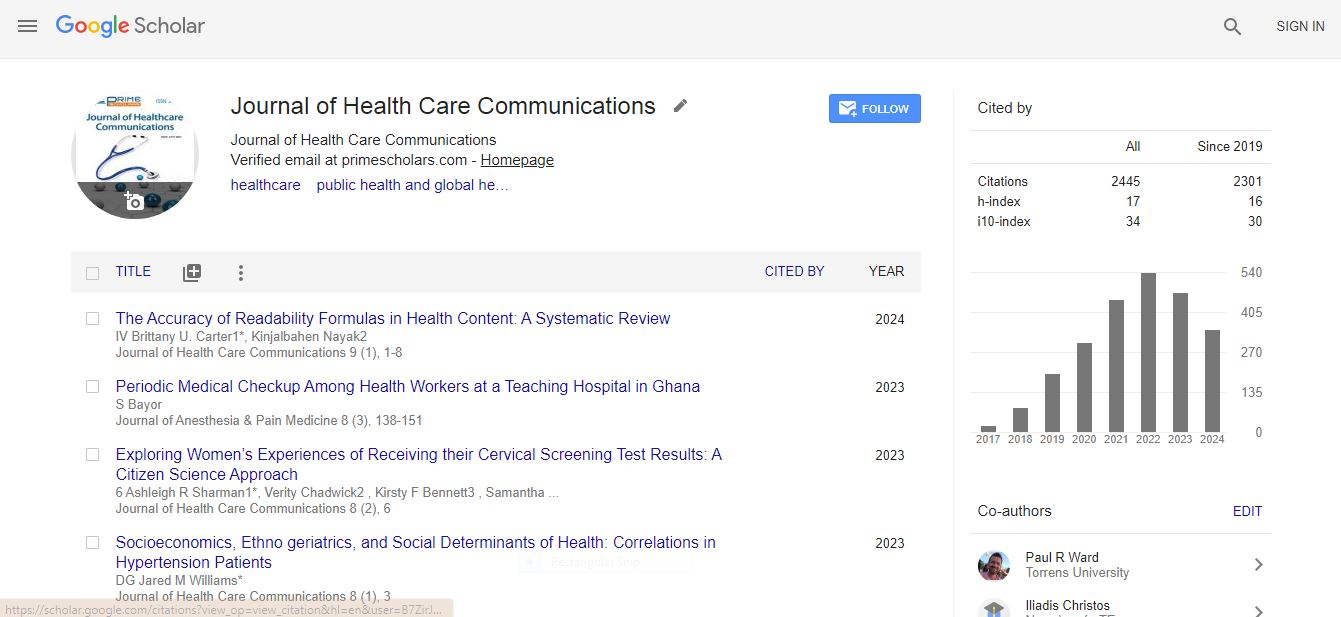Short Communication - (2024) Volume 9, Issue 6
Diagnostic Accuracy in Healthcare: An Essential Measure of Medical Decision-Making
Ananya Gupta*
Department of Public Health, Yale University, USA
*Correspondence:
Ananya Gupta,
Department of Public Health, Yale University,
USA,
Email:
Received: 02-Dec-2024, Manuscript No. IPJHCC-25-22469;
Editor assigned: 04-Dec-2024, Pre QC No. IPJHCC-25-22469 (PQ);
Reviewed: 18-Dec-2024, QC No. IPJHCC-25-22469;
Revised: 23-Dec-2024, Manuscript No. IPJHCC-25-22469 (R);
Published:
30-Dec-2024, DOI: 10.36846/2472-1654-9.6.51
Introduction
Diagnostic accuracy is a critical aspect of healthcare, playing a
pivotal role in the effectiveness of medical decision-making. It
refers to the ability of a diagnostic test or procedure to correctly
identify a disease or condition, distinguishing between those
who have the condition and those who do not. The accuracy
of a diagnostic tool is essential not only for providing correct
diagnoses but also for ensuring that appropriate treatments
are initiated, minimizing unnecessary procedures, and reducing
the potential for misdiagnoses that could harm patients. These
technologies can analyze vast amounts of medical data and
identify patterns that may be difficult for human practitioners
to detect. For example, AI algorithms have been used to
improve the accuracy of radiological images, making it easier
to detect conditions like lung cancer or neurological disorders
at earlier stages.
Description
The concept of diagnostic accuracy can be divided into several
key components sensitivity, specificity, positive predictive
value, and negative predictive value. Sensitivity measures
the proportion of actual positive cases that are correctly
identified by the test. On the other hand, specificity measures
the proportion of true negatives correctly identified, ensuring
that the test does not falsely label healthy individuals as
diseased. The positive predictive value reflects the likelihood
that a positive test result indicates the presence of the disease,
while the negative predictive value indicates the likelihood
that a negative result means the absence of the disease. A test
with high sensitivity and specificity can significantly improve
clinical decision-making, enabling healthcare professionals to
make informed choices about patient care. For example, in the
diagnosis of cancer, a highly sensitive test ensures that patients
who have the disease are not missed, while a highly specific
test reduces the likelihood of false positives, preventing
unnecessary biopsies and treatments. One of the primary
concerns is the transparency of AI models and the potential
for biases in algorithms, which could lead to disparities in
diagnostic accuracy across different populations. Moreover,
the reliance on AI tools may also result in reduced human
interaction in the diagnostic process, potentially impacting
patient trust and the holistic nature of care. Therefore, while
AI can enhance diagnostic accuracy, it should complement, not
replace, the expertise of healthcare professionals [1-4].
Conclusion
In conclusion, diagnostic accuracy is a fundamental element
of effective healthcare. It is influenced by a combination of
factors, including test sensitivity, specificity, and the quality
of the diagnostic tools employed. As technology continues to
evolve, so too will the accuracy of diagnostic tests, with AI and
machine learning holding considerable promise in improving
medical outcomes. However, maintaining a balanced approach
that incorporates both technological advancements and the
clinical judgment of healthcare providers will be essential in
ensuring that patients receive the most accurate diagnoses and
best possible care.
Acknowledgement
None.
Conflict Of Interest
The author declares there is no conflict of interest.
References
- Mileman PA, Hout WB (2009) Evidence-based diagnosis and clinical decision making. Dentomaxillofac Radiol. 38(1):1-10.
[Crossref] [Google Scholar] [PubMed]
- Croskerry P, Nimmo G R (2011) Better clinical decision making and reducing diagnostic error. J R Coll Physicians Edinb. 41(2):155-166.
[Crossref] [Google Scholar] [PubMed]
- Kannampallil TG, Schauer GF, Cohen T, Patel VL (2011) Considering complexity in healthcare systems. J Biomed Inform. 44(6):943-947.
[Crossref] [Google Scholar] [PubMed]
- Touati F, Tabish R (2013) U-healthcare system: State-of-the-art review and challenges. J Med Syst. 37(3):9949.
[Crossref] [Google Scholar] [PubMed]
Citation: Gupta A (2024) Diagnostic Accuracy in Healthcare: An Essential Measure of Medical Decision-Making. J Health Commun. 9:51.
Copyright: © 2024 Gupta A. This is an open-access article distributed under the terms of the Creative Commons Attribution License, which permits unrestricted use, distribution, and reproduction in any medium, provided the original author and source are credited.

